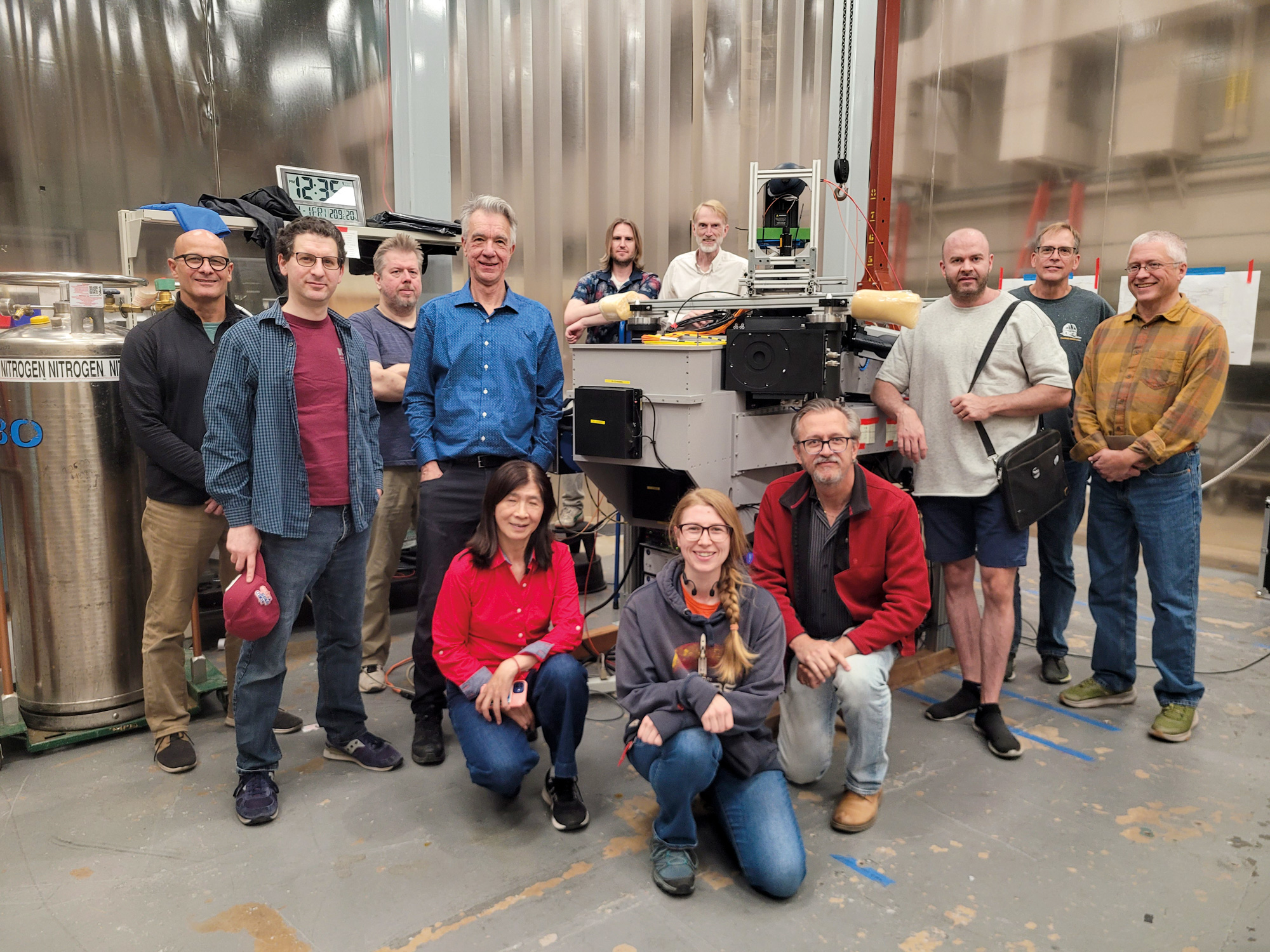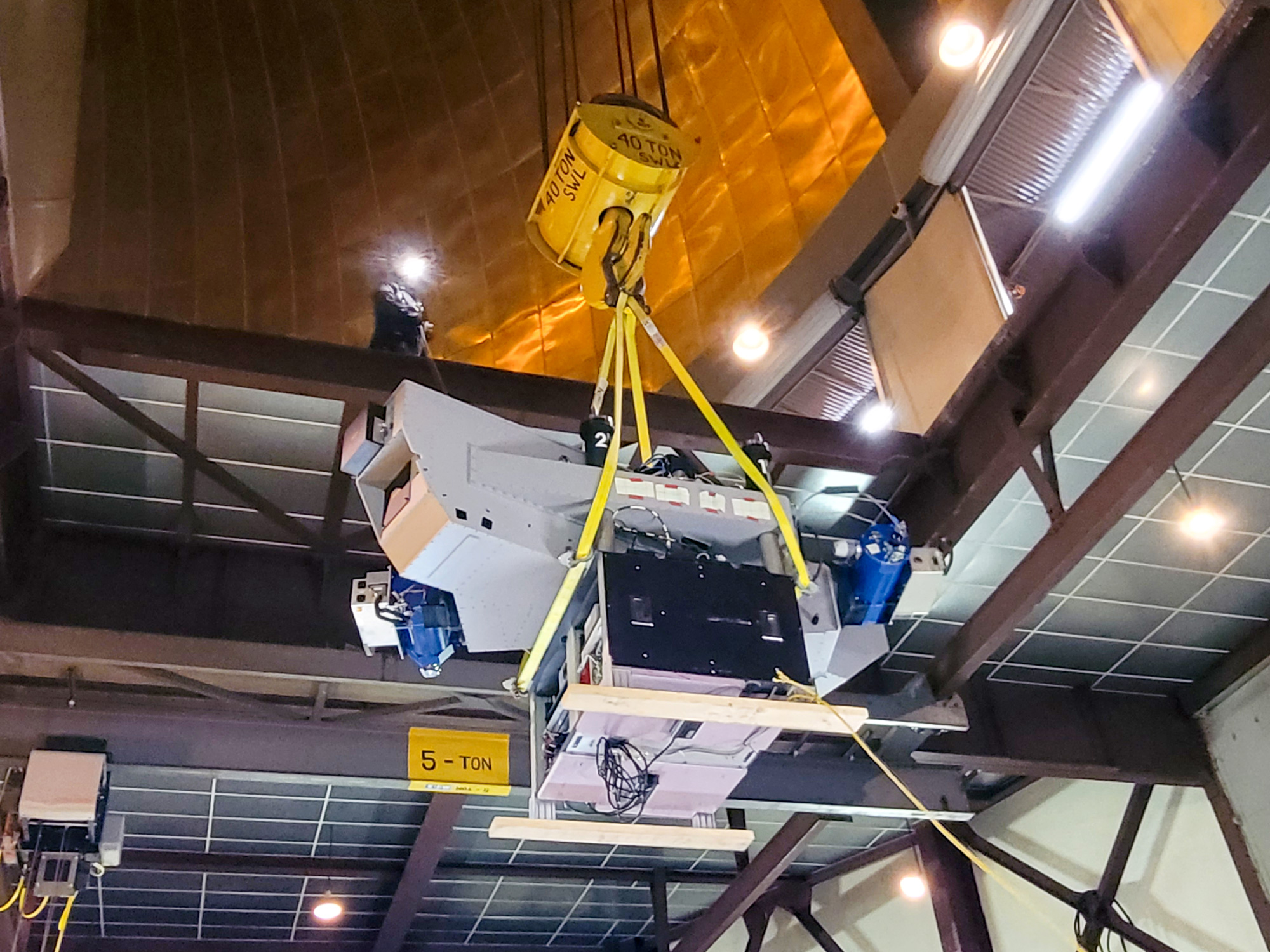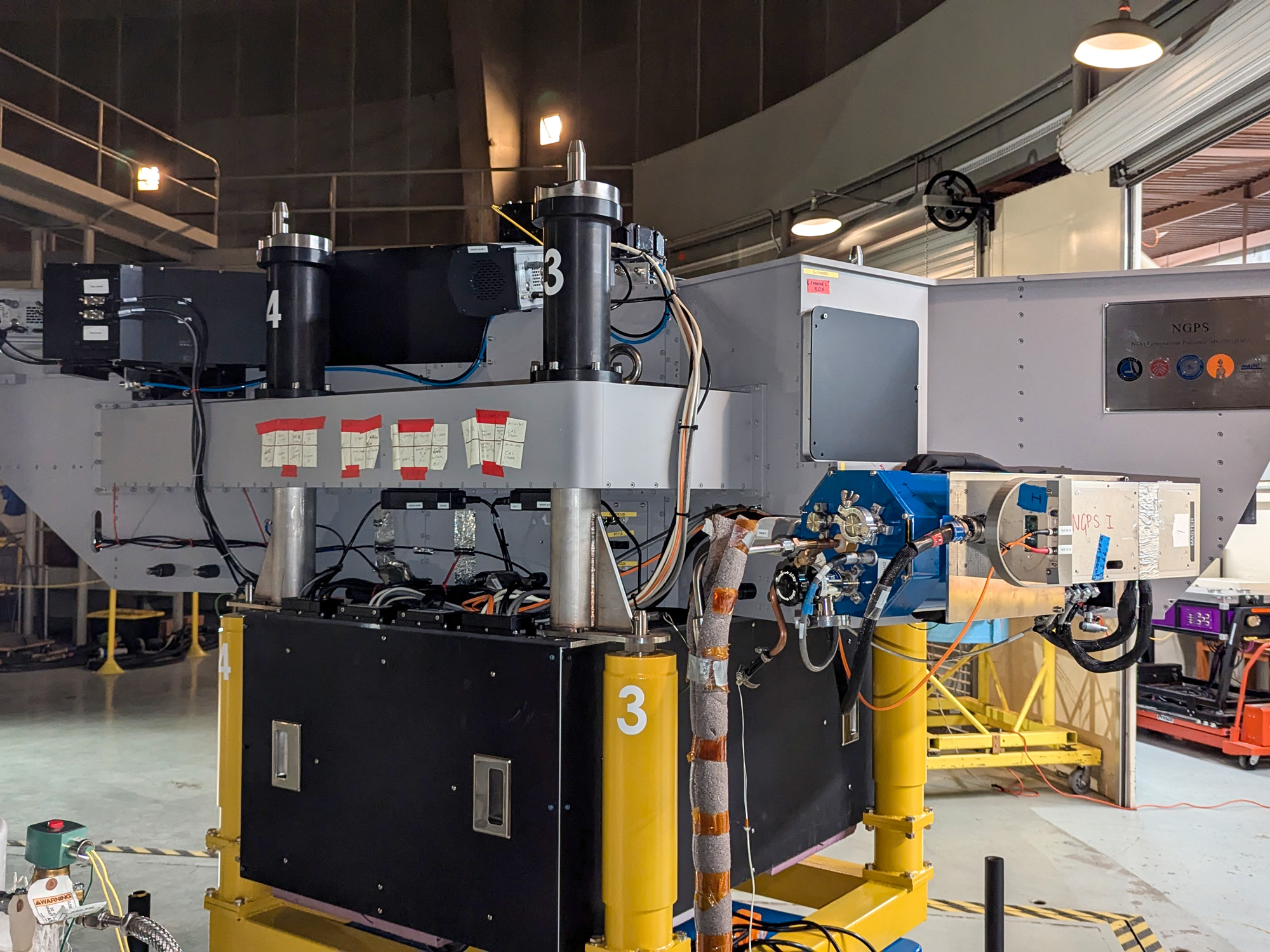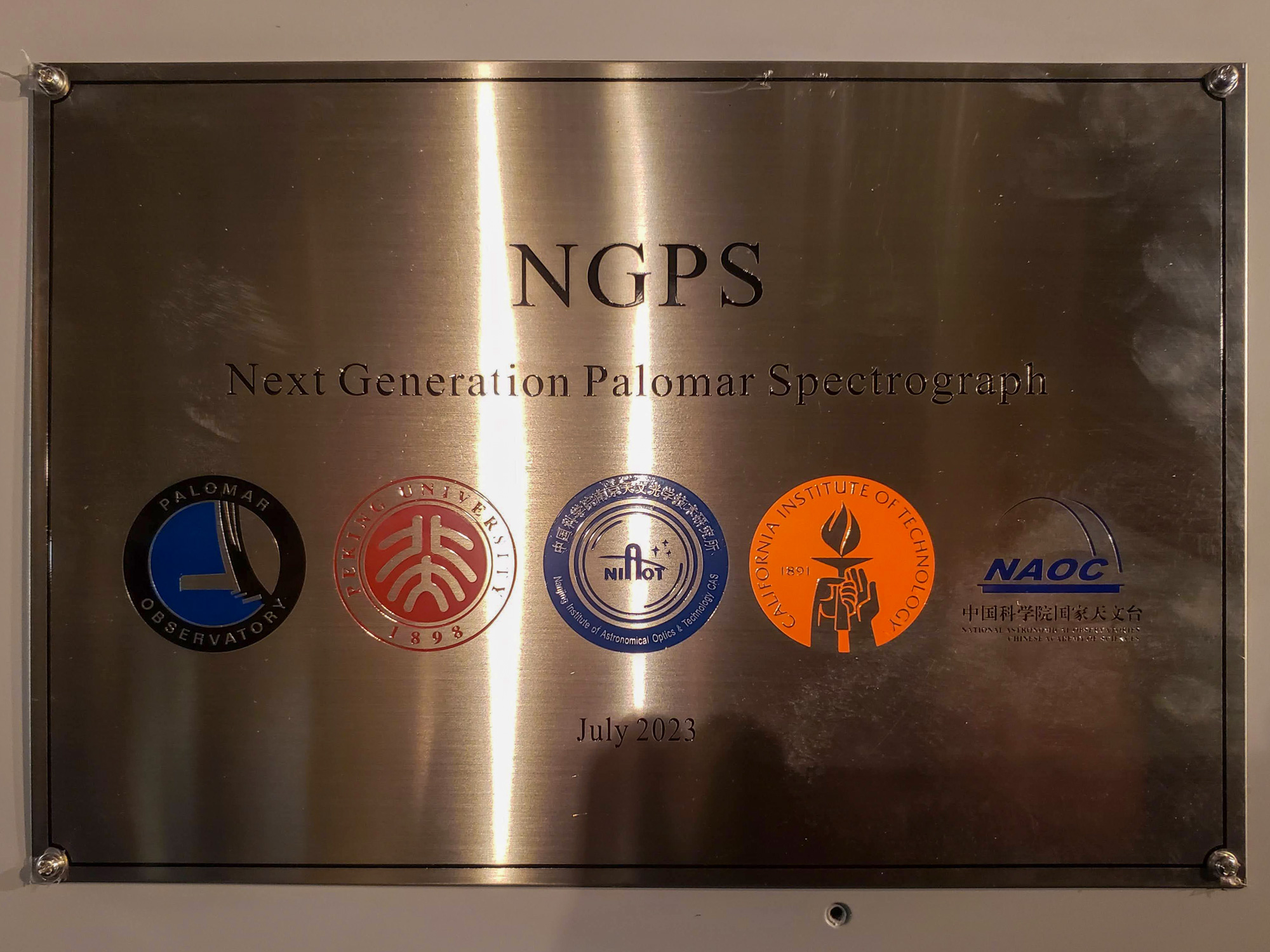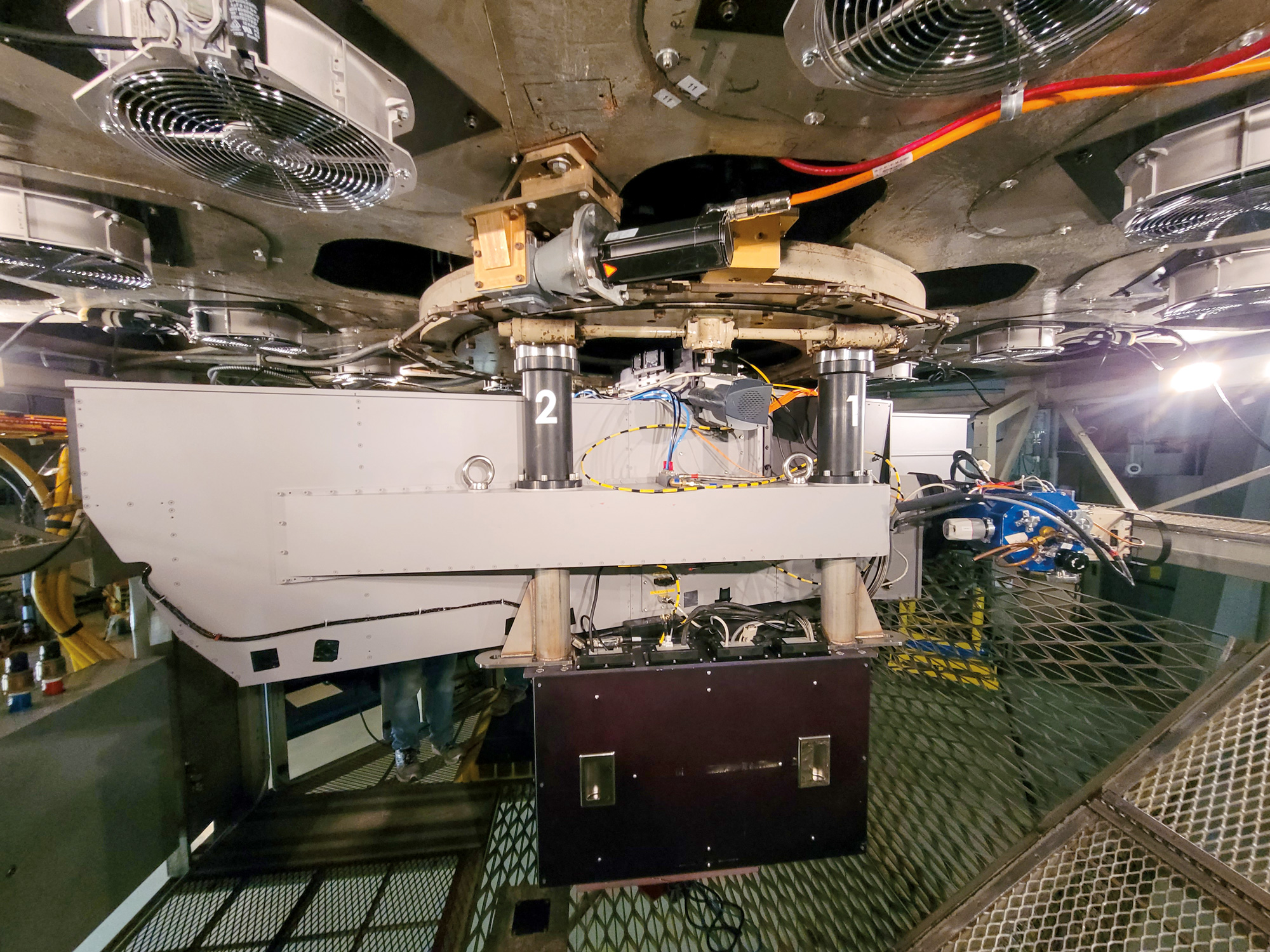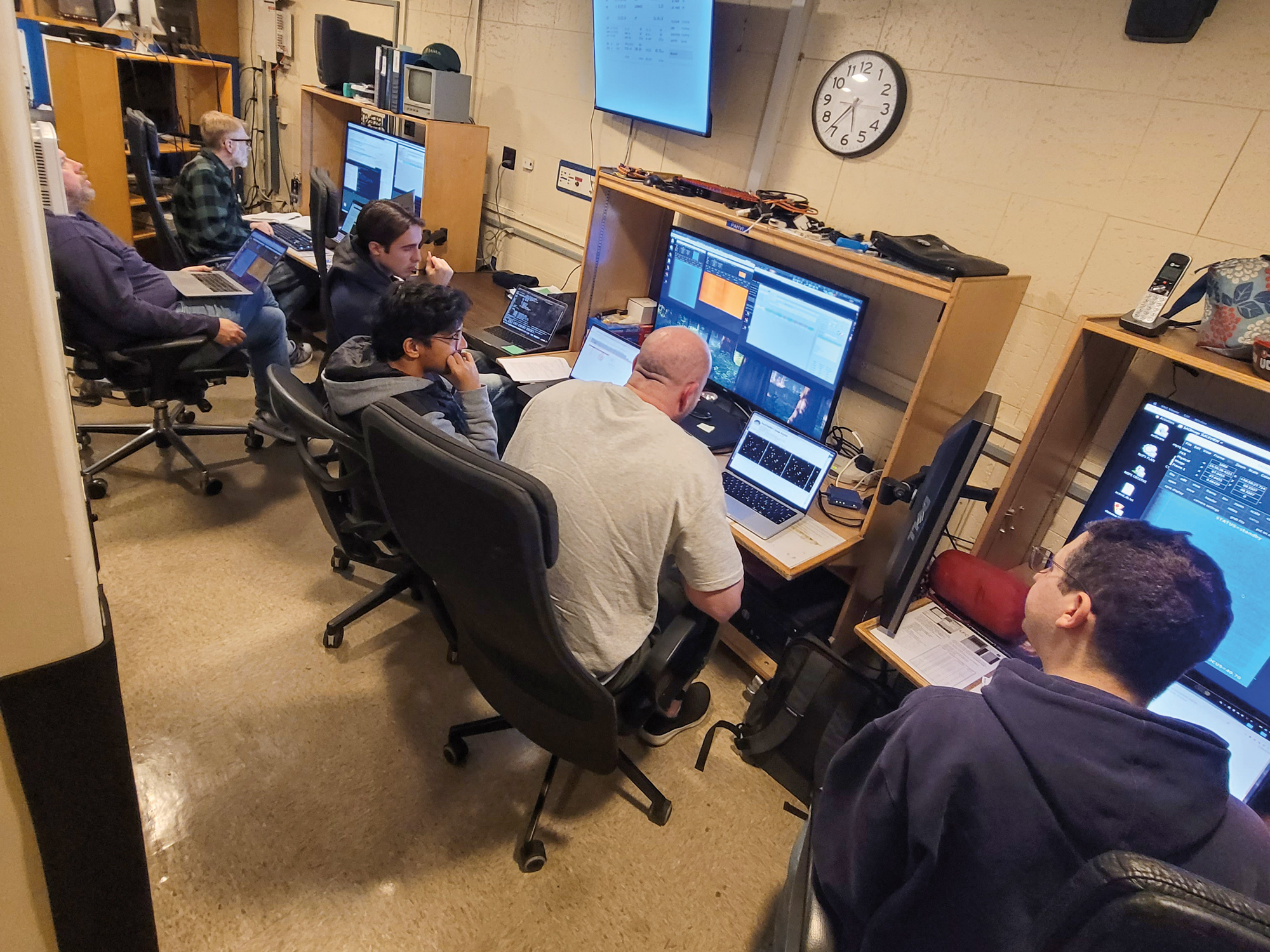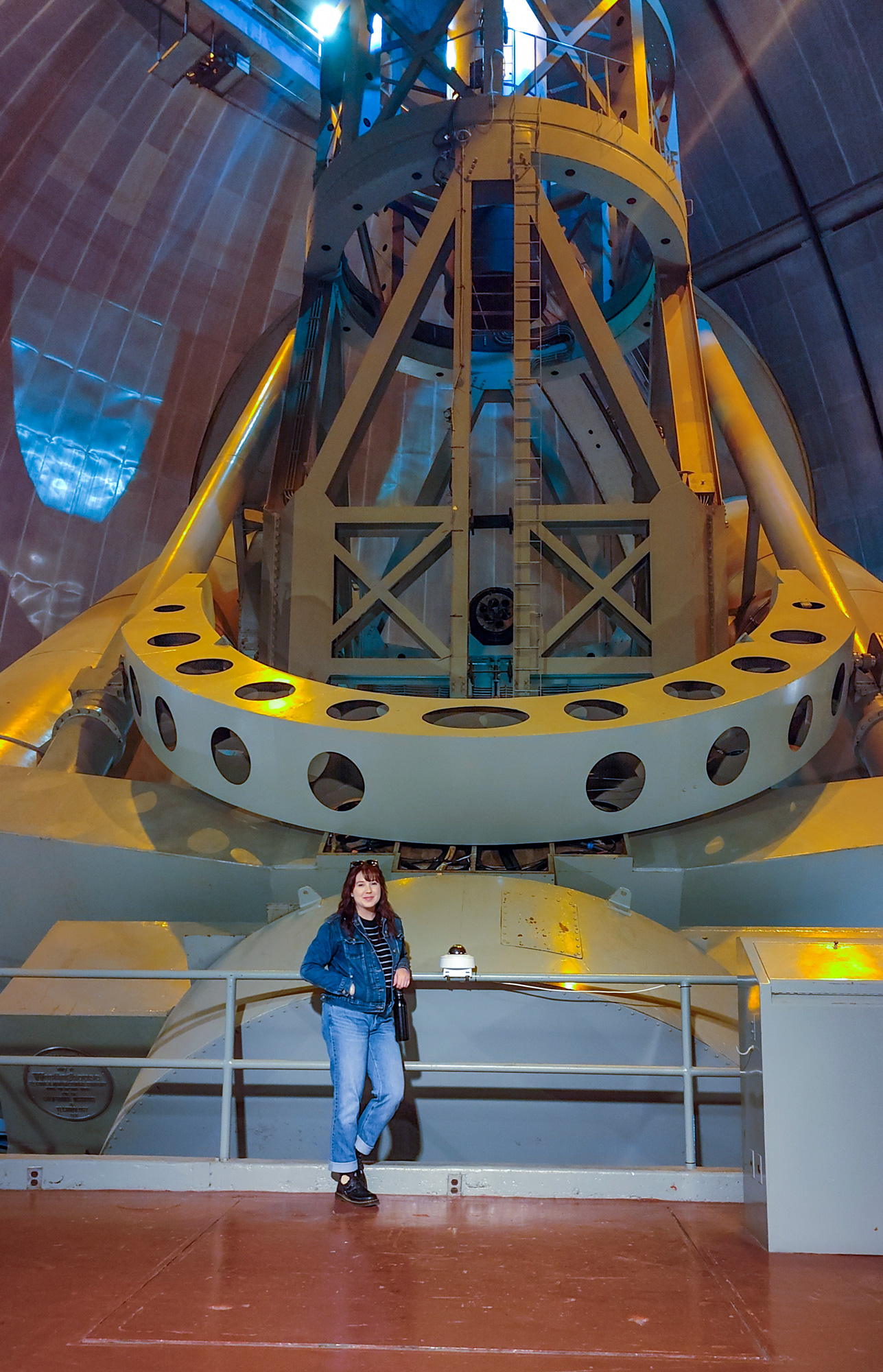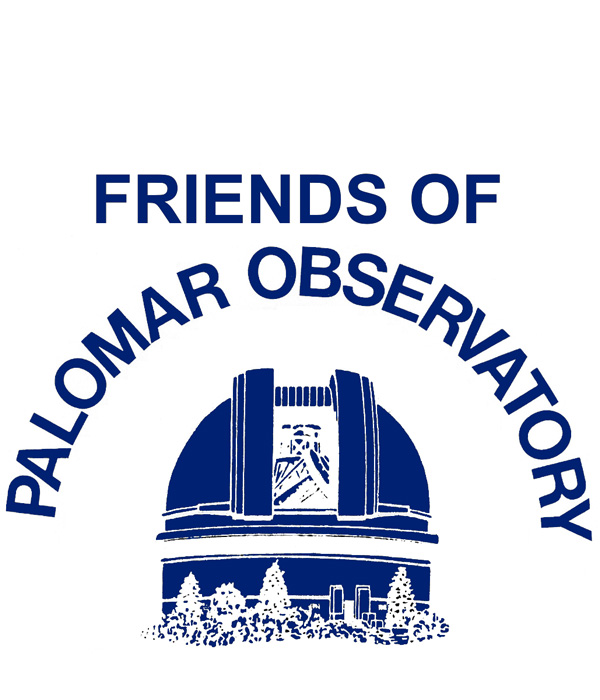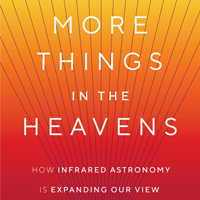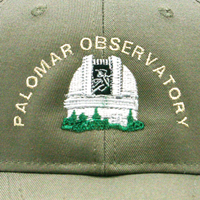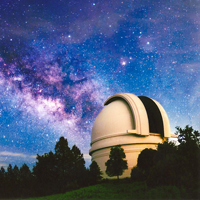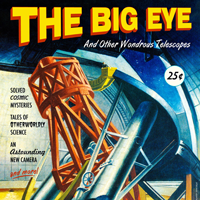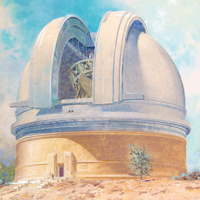
The Newsletter of the Friends of Palomar Observatory, Vol. 19 No. 1 – May 2025
NGPS First Light November 2024
By Andy Boden
NGPS install. More images in this album. (Palomar/Caltech)
We often get the question “what do you use the Hale Telescope for, anyway?” The answer would be a lot of different things, but more often than not we spend most of the telescope time dividing received light into its different colors—spectroscopy. Most professional astronomers are preoccupied with taking and analyzing spectra for various purposes.
Since the 1980s the primary optical spectrograph on the Hale has been the venerable Double Beam Spectrograph (DBSP). DBSP is so named because it operated with two separate cameras covering blue and red wavelengths, with the separation between the two at a wavelength around 5500 angstroms (depending on configuration). That DBSP served as the Hale’s workhorse optical spectrograph for so long is a testament to its rock solid design and construction, its adaptability and configurability to cover many different use cases, and particularly the ability to upgrade the instrument as better technology (e.g. CCD cameras) became available.
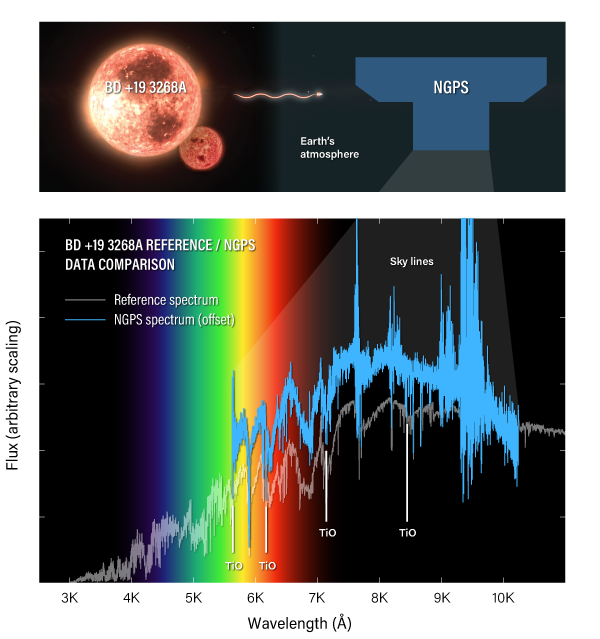
20 April 2025 NGPS two-channel spectrum on source BD +19 3268A in blue (scaled to approximately match in flux normalization) along with a reference spectrum. The match between the NGPS spectrum and the reference spectrum is quite good (e.g. prominent broad absorption features in the spectrum match expectations from molecular absorption—titanium oxide (TiO)—and are typical of cool stellar atmospheres). The noisy portions of the NGPS spectrum result from Earth’s atmospheric absorption (e.g. the data around 7600 Å results from the diatomic oxygen “A” band. (A. Boden/A. Mejia/NASA)
Still time has its way with all of us—astronomical instruments included, and several years ago we decided it was time to replace DBSP with a new optical spectrograph incorporating 40+ years of new design concepts and technology. In 2018 Caltech teamed with Hale partner institution the National Optical Observatories of China (NAOC) to develop a new facility spectrograph. After an all-to-interesting development phase featuring a global pandemic the Next Generation Palomar Spectrograph (NGPS) arrived at Palomar in November 2024.
The primary design objective with NGPS is to increase the instrument optical throughput to be significantly more sensitive than DBSP. The sensitivity gain is enabled with new dispersive element technology; replacing traditional diffraction gratings are volume phase holographic (VPH) gratings that are typically a factor of a few more light-efficient. Initial observational testing confirms the design goals have been met and the system is roughly a factor of three more efficient than DBSP. The instrument has also been simplified in its configuration with fixed dispersion (R ~ 4000), simplifying installation and calibration. Relative to DBSP, NGPS is configured to use four separate CCD cameras: as currently deployed for semester 2025A (February – July 2025 inclusive) science operations only two of these cameras are in place instrumenting the r (red: 5810 – 7820 angstroms) and i (near-infrared: 7560 – 10400 angstroms) spectrograph “channels.” Populating and commissioning the two blue channels (wavelengths from 3600 – 5810 angstroms) is scheduled to begin in September 2025.
In the midst of typically sketchy November Palomar weather the first spectrum with NGPS was obtained on Friday 15 November 2024, allowing the team to classify a ZTF-detected Type 1a supernova (Kasliwal et al. 2024):
On 2024-11-15 04:43 UT, we obtained a classification spectrum of SN 2024aagp during the first commissioning run of the Next Generation Palomar Spectrograph (NGPS) on the Palomar 200-in Hale Telescope (TNS Classification Report No. 18714). The spectrum shows a broad Si II absorption feature commonly observed in Type Ia supernovae. The Si II 6355 absorption minimum corresponds to a velocity of approximately 12,500 km/s. Comparison with the NGSF (NextGeneration SuperFit; Astronote 2022-191, Howell et al. 2005) spectral library indicates a match to several normal Ia SNe, including SN 2011by, SN 2011fe, roughly 2–5 days before peak brightness. Based on host galaxy emission lines in the NGPS spectrum, we derive a redshift of 0.045.
In 2025A the broader Palomar community is getting their first opportunity to use NGPS in a science context. I recently had my own first run with NGPS in mid-April 2025, observing a small set of M-dwarf systems (objects well-matched to present wavelength coverage). The figure above shows the reduced NGPS spectrum on a sample system from my run (in blue) compared with reference information from independent sources. The match between the NGPS spectrum and the reference spectrum is good (see figure caption for details).
The Palomar community is excited for this emerging instrument and the results it will produce. Among our various constituencies we have over 50 nights of NGPS observations scheduled in 2025A, and early indications are that demand is only increasing for semester 2025B (August 2025 – January 2026 inclusive). It has been an extended effort from 2018 conception to first science with the new spectrograph, but all indications are that the results appear worth it. On behalf of the observatory community we congratulate the NGPS development team for accomplishing this important milestone. As for DBSP, its long and distinguished service to generations of Palomar astronomers will be fondly remembered. And its service is not quite done: DBSP is presently being decommissioned, and its two CCD cameras are being refurbished for reuse in the two blue NGPS channels in the fall.
References
- M. Kasliwal et al (16 November 2024) AstroNote 2024-340.
- B. Oke & J. Gunn (June 1982) An Efficient Low Resolution and Moderate Resolution Spectrograph for the Hale Telescope. PASP, 94, 586.
- NGPS website.
Hale Observations in Modern Astrophysics Part III: Transiting Exoplanets
By Andy Boden
The pandemic years saw a disruption in all our lives; many things that we took for granted suddenly became difficult for or inaccessible to us and we were all left wondering how things could have changed so suddenly. At the same time, and largely while we were all mostly distracted with changes in our own realities, remarkable advances in exoplanet observation were happening on the Hale Telescope at Palomar Observatory.
As of spring 2025 astronomers have confirmed the existence of almost 6000 planets around stars other than our Sun (so called exoplanets). Starting from the first unexpected discoveries in the mid-1990s (see 2019 Nobel Prize in Physics), we have come to understand that most stars in our galaxy host planets—at least during the “main sequence” parts of their lives. Astronomers study exoplanets using various techniques, but among the most productive detection methods to date has been the “transit” method where an exoplanet passes in front of its host star as viewed from our perspective. This method has been used to great effect both on the ground and in space where several space missions (e.g. Kepler, TESS) have discovered large exoplanet samples. In addition to providing large samples the transit technique has another important advantage—it can provide a direct measurement of an exoplanet’s size (technically its radius ratio relative to its host star).
With these large samples and size measurements astronomers have for the first time been able to look beyond the Solar System to see the great diversity of exoplanets in our galaxy. Among the more remarkable discoveries is the inference of interesting size characteristics for rocky exoplanets. Using Kepler results Caltech astronomers B.J. Fulton, Andrew Howard, and collaborators discovered the so-called “Fulton gap”, an observed scarcity of rocky planes in a particular size range thought to be driven by atmospheric photoevaporation (Fulton et al. 2017). In the past decade exoplanet astronomy has been dominated by an emerging awareness of a much richer tapestry of planetary demographics than previously known.
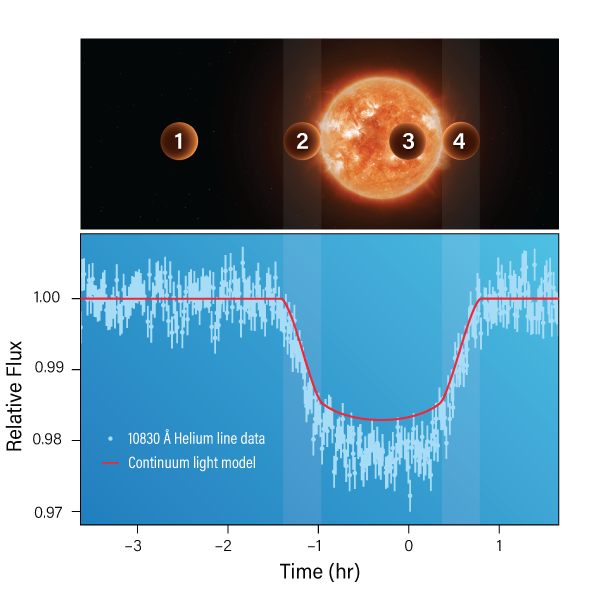
Phased Palomar light-curve for the hot jupiter WASP 69b. The planet “appears” larger (lower intensity) at 10830 Å (data points) than in continuum light outside the spectral line (model). This in-line larger apparent size traces the excited emission from escaping gas due to photoevaporation. (Visssapragada et al/A. Mejia/ESA).
Remarkably, enterprising Palomar astronomers have developed methods to make Palomar’s 200-inch Hale Telescope surprisingly relevant in our evolving understanding of exoplanet populations. Caltech Professor Heather Knudson and her students had the insight that the Wide-Field Infrared Camera (WIRC) on the Hale could be well-matched to exoplanet transit followup studies provided that near-infrared light from the parent star was intentionally diffused over many detector pixels (see also Flanders 2017: Weather Reports on Exoplanets, Big Eye 12-3). You read that right: improving the precision of relative photometry is accomplished by intentionally diffusing the star image over many pixels—allowing for collecting much more stellar light in the linear range of the WIRC detector array. The resulting time-series photometry (in astronomy speak, light-curve) on known planet-hosting stars is nothing short of extraordinary. The figure shows an example of a Hale Telescope transit light-curve for a known exoplanet (WASP 69b, Vissapragada et al. 2020). The demonstrated relative photometric precision is similar to data provided by exoplanet transit space missions—good to a few parts in 1000, and allows the few percent apparent dimming when the planet passes in front of its parent star to be easily seen even without sophisticated data analysis. The capability of routinely making “millimagnitude” relative photometric observations from the ground is game-changing, and makes detailed followup study of specific systems viable.
Having developed these new observational capabilities with the 200-inch and WIRC, what have Prof Knudson and students done with them? Well, a couple of really important projects over the past several years actually. The first project we’ll mention is a survey of atmospheric photoevaporation relevant to the Fulton gap we mentioned above. The working hypothesis to explain the Fulton gap is that planets near their host stars and in a certain mass range are prone to atmospheric loss through photoevaporation (i.e., radiation from the star disperses the planetary atmosphere via ionization). Evidence for this process is found in exoplanet transit spectroscopy of a particular line of helium at roughly 10830 Å wavelength. Working with Prof. Knudson Caltech Graduate Student Shreyas Vissapragada used the WIRC diffusion method combined with an ultra narrow band filter centered on the 10830 Å He line to survey nearly 100 stars and put important constraints on atmospheric mass-loss rates from photoevaporation, supporting this interpretation as the physical mechanism behind the Fulton gap.
A second separate study is the Ph.D. thesis project of Caltech’s Michael Greklek-McKeon. Compared with sizes, measuring exoplanet masses is considerably harder, and relatively few exoplanets have reliable mass measurements. But mass and radius measurement together are critical to understand exoplanet bulk properties and to study how these populations compare with the familiar planets in our Solar System. In systems with multiple transiting exoplanets, variations in the transit times resulting from mutual gravitational interactions can be used to estimate the planet masses. Greklek-McKeon and Knutson have used WIRC light curves to measure these Transit Timing Variations (TTVs) for a handful of multiple exoplanet systems over the past several years with the goal of improving mass estimate constraints for rocky exoplanets with bulk properties consistent with significant water content.
Having just celebrated the Hale’s 75th anniversary in 2023, these important results underscore the prominent role the 200-inch continues to play in the modern astrophysics landscape (see previous articles Part I and Part II on current-day Hale programs exploring other important astrophysical questions). We are all grateful to call ourselves part of the Palomar community, and are excited to see where the next remarkable discovery thread will emerge.
References
- S. Flanders (September 2017) Weather Reports on Exoplanets. Big Eye, 12, 3.
- B. Fulton et al (24 August 2017) The California-Kepler Survey. III. A Gap in the Radius Distribution of Small Planets. AJ, 154, 109.
- S. Vissapragada et al (28 May 2020) Constraints on Metastable Helium in the Atmospheres of WASP-69b and WASP-52b with Ultranarrowband Photometry. AJ, 159, 278.
A new Palomar Team Member
We’re thrilled to welcome Ashley Wilkinson as our new Outreach Coordinator at Palomar Observatory.
Ashley brings a wealth of experience in science education, astronomy outreach, and student engagement. She joins us from the University of North Texas (UNT), where she spent several years in the Physics Department as an Undergraduate Coordinator and STEM Outreach Ambassador. Her work included organizing major solar eclipse events, developing public programming, mentoring students, and supporting department-wide initiatives that reached thousands across the community.
Ashley has also led planetarium shows, field trips, and virtual astronomy events, educating over 15,000 students annually through dynamic and accessible programming. Her passion for making science inclusive and engaging shines through in everything she does—from building astronomy trivia nights to mentoring young women in physics.
She holds a Bachelor of Science in Education from UNT and has served in a wide range of roles, including console operator at the UNT Sky Theater, educator at the Frontiers of Flight Museum, and summer camp instructor in space and Earth sciences.
At Palomar, Ashley will coordinate on-site support for public, educational, and media-related events. She will also oversee the docent program, contribute to public outreach strategy, and help lead the observatory’s social media presence—with a special focus on expanding our reach to young adults. Working closely with the Caltech Optical Observatories Director’s Office, Ashley will play a key role in shaping the observatory’s future outreach efforts.
We’re excited for the creativity and energy she brings to our team—welcome, Ashley!
Questions? We've answered many common visiting, media, and academic questions in our public FAQ page.
Please share your feedback on this page at the
COO Feedback portal.
Big Eye 19-1
Last updated: 15 May 2025 AFB/ACM
